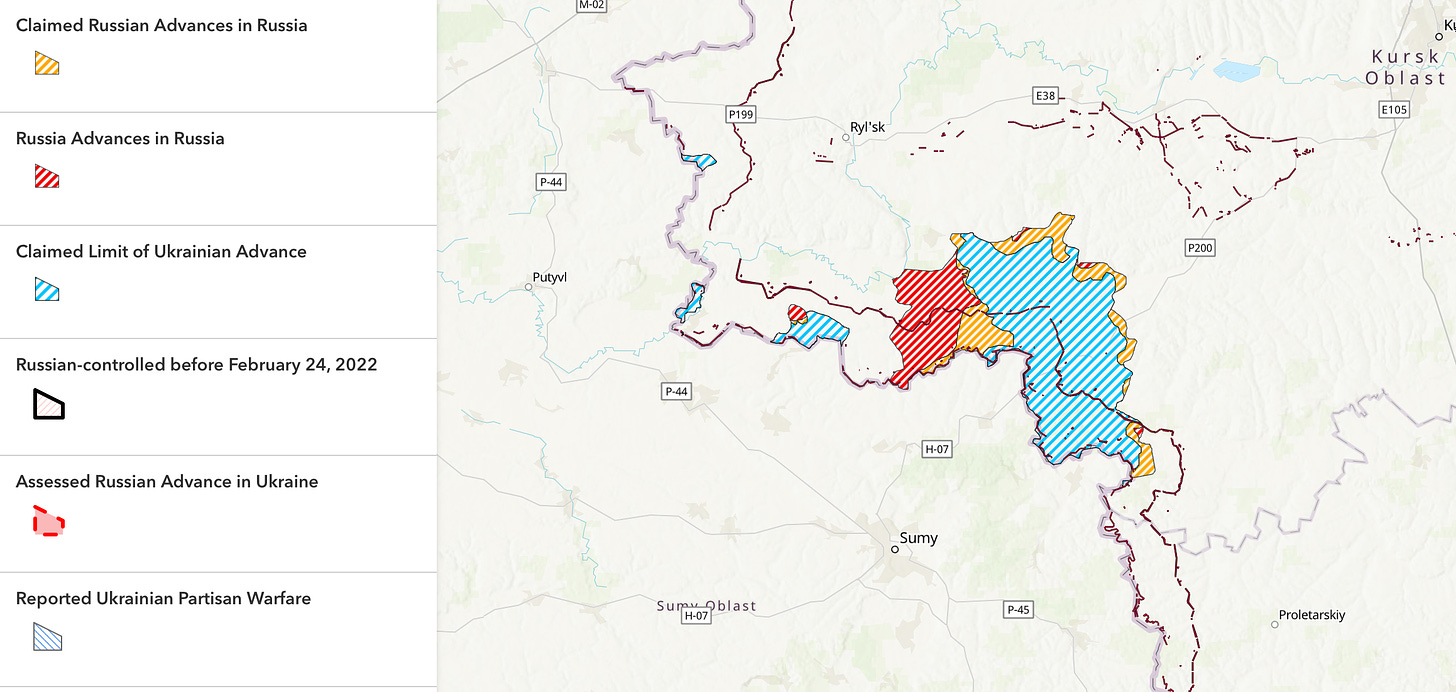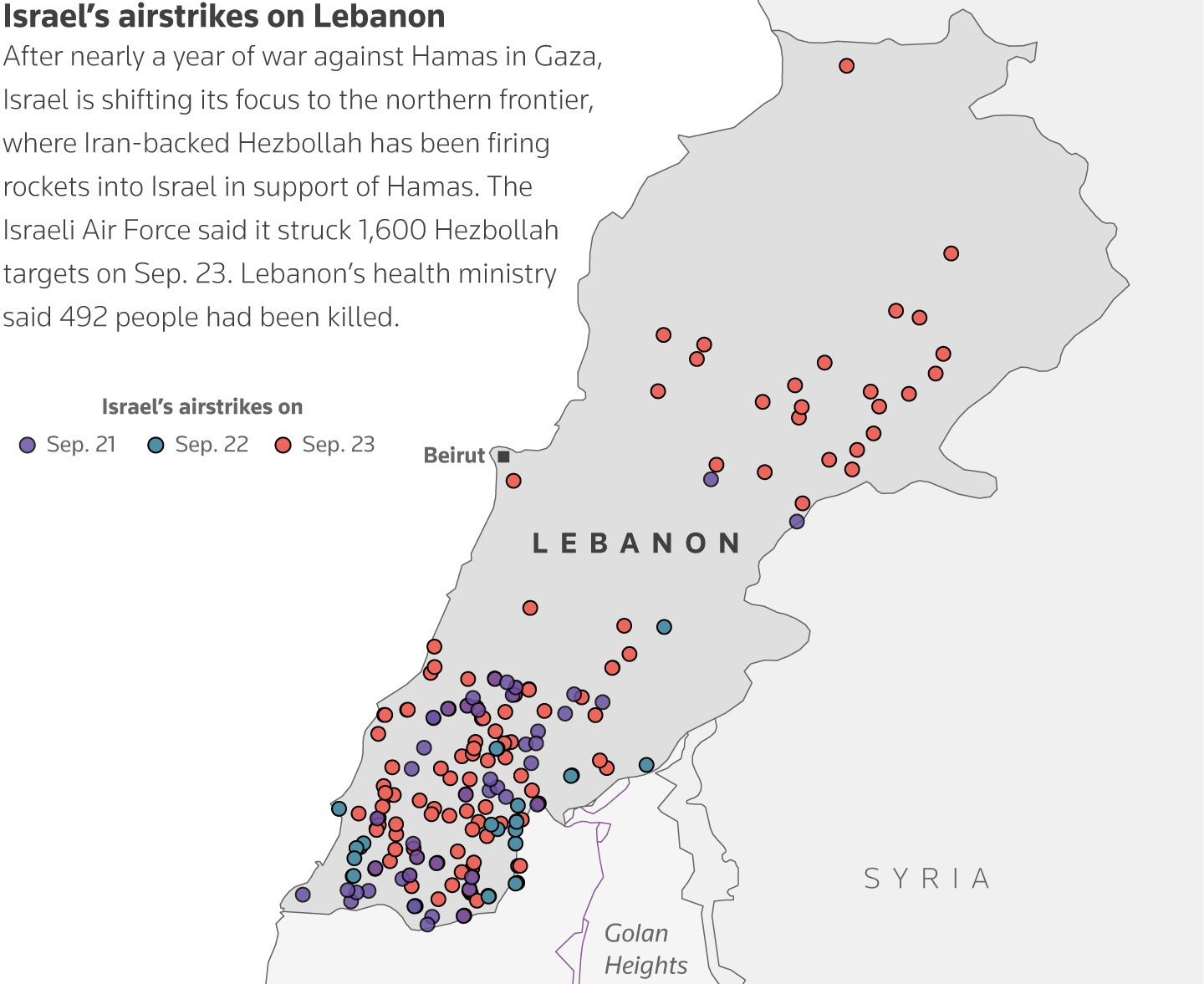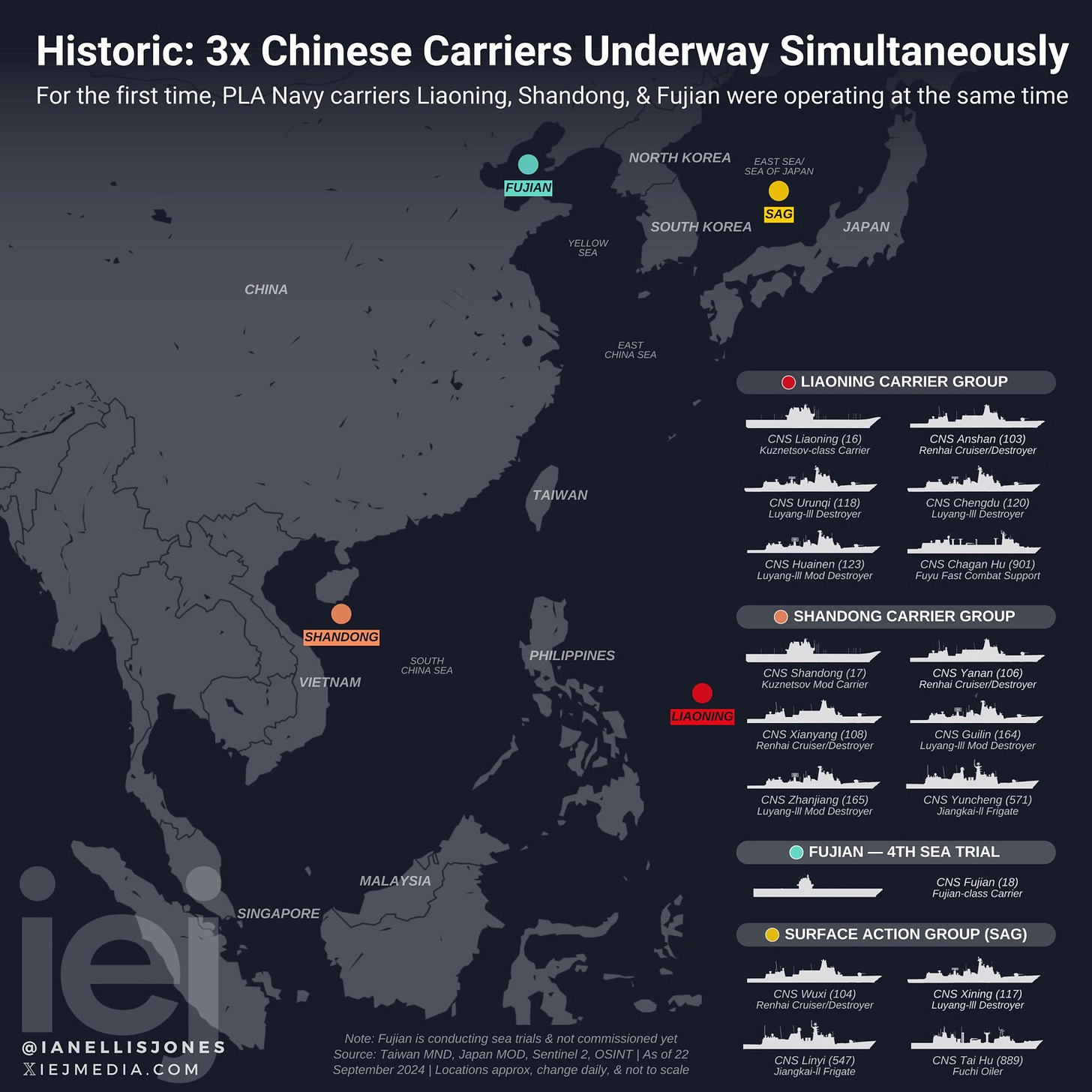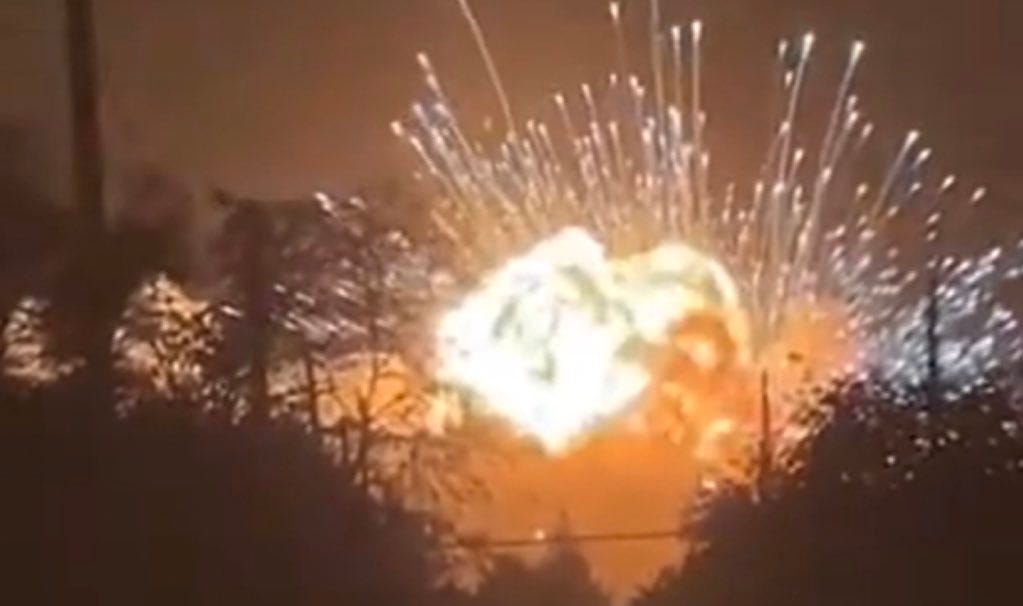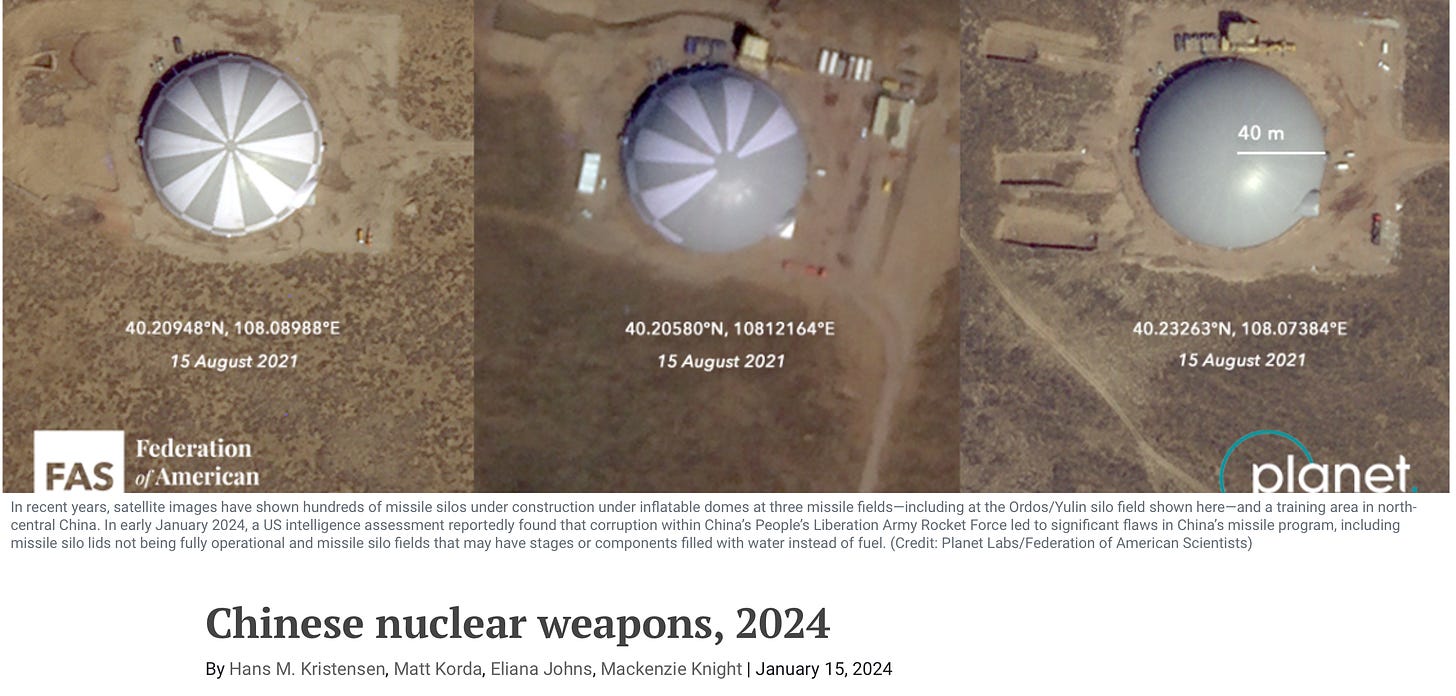The Big Five - 27 September edition
My regular update on conflict and confrontation in Ukraine, the Middle East and the Pacific, accompanied by recommended readings on the character of modern war and planning for future conflict.
We continue to live in interesting times. Here is my (long) update on Ukraine, the Middle East and the Pacific, as well as my top five recommended readings for this week.
The Russo-Ukraine War
Five key topics dominate reports on the war in Ukraine and Russia this week.
First, the Ukrainians have conducted strikes on at least three major Russian munitions storage depots. I wrote about these strikes in a piece earlier this week. Stocks of S300 and S400 missiles were among the stocks destroyed, as well as munitions provided by North Korea. While the effects of these attacks are not certain, it is possible they will restrict the supply of some natures of ammunition to Russian forces in Ukraine. An estimate from Estonian military intelligence noted that the destruction at the Russian munition depots would have an impact on Russian operations over the coming months.
A second topic of focus this week has been the ongoing Ukrainian campaign in Kursk. The Russian counter attack appears to have gained some ground in the western parts of the Ukrainian salient, however the tempo of this counter attack has slowed significantly. The Ukrainian incursion to the west of where the Russian counter attacked has potentially compromised the flank security of the Russians, and reportedly has cutoff hundreds of Russian troops.
Besides that however, the Ukrainians appear to be focussed on consolidating what ground they currently hold and digging in to begin a defensive campaign to attrit attacking Russian forces. Unfortunately, the Ukrainian Kursk operation does not (yet) appear to have drawn sufficient Russian troops from Ukraine to have a major impact on the Russian advances in the Donbas.
Which brings me to the third important topic: Russia’s advances in the Donbas. The Russians are largely maintaining their offensive tempo in eastern Ukraine. They have advanced on several axes of advance, which must be placing enormous pressure on the Ukrainian general staff to deploy reserves and stem the losses in troops and Ukrainian territory. This military pressure is sure to translate into political pressure on the Zelenskyy government, particularly as the Kursk campaign does not appear to have slowed Russia’s main effort in the Donbas.
The fourth key topic is Putin’s announcement about changes in Russia’s nuclear doctrine. In essence, Russia might now target non-nuclear nations who are supported by a nuclear armed country.
The final interesting topic this week has been the Zelensky visit to the United States and his discussions about the new Ukrainian Victory Plan. While we are yet to see this plan, it is being sold as a way to support Ukraine and force the Russians to negotiate a ceasefire or war termination agreement that is favorable to Ukraine. Another unknown is how much more support Ukraine will be requesting, and whether their Victory Plan aligns with the new U.S. strategy for Ukraine that was recently sent to Congress.
Zelenskyy met with members of the U.S. Senate, met with President Biden and held a press conference with Vice President Harris. Unfortunately, the bipartisan consensus about Ukraine in the war’s early months appears to have broken down.
Before getting on the plane to return home, Zelenskyy also met with former president Trump on Friday morning (Washington DC time). After the meeting Zelenskyy tweeted the following:
I had a very productive meeting with @realDonaldTrump. I presented him our Victory Plan, and we thoroughly reviewed the situation in Ukraine and the consequences of the war for our people. Many details were discussed. I am grateful for this meeting. A just peace is needed.
It is hard to imagine Trump, Vance and other republicans walking back some of their tough rhetoric on the war and Ukraine. As he noted during their meeting:
I think the fact that we’re even together today is a good sign, and hopefully we’ll have a good victory because if the other side wins, I don’t think we’re going to have victories with anything, to be honest with you.
The report on the meeting from Politico described how “Trump said he “learned a lot” and claimed that if he wins, Ukraine and Russia will reach “a very fair and I think, actually, a rather rapid deal,” but said it was “too early” to share his plans to end the war.” OK. This is hardly an endorsement of Ukraine’s plan to end the war on terms favorable to them.
In final Ukraine news, U.S. administration also announced during the Zelenskyy visit a significant package of support which included:
The U.S. Department of Defense is to allocate all of its remaining security assistance funding that has been appropriated for Ukraine by the end of the Biden term in office. $5.5 billion in Presidential Drawdown Authority has been authorised.
The Department of Defense announced $2.4 billion in security assistance through the Ukraine Security Assistance Initiative.
Provision of the Joint Standoff Weapon (JSOW) long-range weapon.
An additional Patriot air defense battery and additional Patriot missiles
Expanded training for Ukrainian F-16 pilots, including an additional 18 pilots in 2025.
The German Bundestag this week announced 400 million euro increase in military funding for Ukraine to enable the purchase of air defense systems, tanks, drones, ammunition, and spare parts. The French President stated during a meeting with President Zelensky that France will train and fully equip a Ukrainian brigade.
The Middle East
The Grim Beeper attacks continue to reverberate throughout southern Lebanon. There is no doubt that this has had a profound psychological impact on Hezbollah. Their members no longer know which means of communications to trust, and this is corrosive in any organisation. It will have degraded the responsiveness and flexibility of the organisation, and will have sent a message that the Israelis can find and target individual Hezbollah members where and when they want to.
The Israelis this week not only conducted an air strike that appears to have decapitated the Hezbollah Radwan force leadership, but also attacked what they described at Hezbollah’s ‘main headquarters’ in Beirut. The IDF has also targeted and destroyed many of Hezbollah’s missile stocks. Around 1600 strikes were conducted by the IDF, which is a very significant level of effort for their Air Force. There were a large number of casualties on the ground, and the balance of civilians and Hezbollah in the casualty numbers remains unknown. Hezbollah is estimated to possess somewhere between 100 and 200 thousand missiles of varying range and precision, so just how much of an impact these strikes will have on Hezbollah’s capacity remains to be seen.
Hezbollah also launched a ballistic missile at Tel Aviv. The alleged target was the headquarters of Mossad. The missile was intercepted by the IDF, but was an indication of Hezbollah capacity, and the potential for further escalation in the Israel-Hezbollah conflict.
The big question is whether these attacks are designed to deter Hezbollah from any escalation or are shaping operations for a larger scale Israeli ground operation in southern Lebanon. This is something that the IDF has been thinking about and preparing for over the past decade, so we might expect a different concept of operations compared to their previous large-scale operation in southern Lebanon in 2006. While there are many uncertainties about such an operation, Effects Based Operations will probably not be a feature this time!
The government of Israel has made clear that it wants the citizens of northern Israel who have been evacuated since October 2023 should be able to return to their homes. Conducting a large ground and air operation in southern Lebanon may be part of ensuring this happens.
The Pacific
In the Pacific this week, the big news was the Chinese launch of an ICBM from southern China and which travelled east out across the Pacific between the northern Phillipines and southern Taiwan. It was the first such launch in four decades. I am sure that China was sending a message to two of its neighbors besides undertaking a technical check of their missile. This test is probably part of the ongoing testing and development of new and improved missiles, and part of the broader expansion of China’s nuclear deterrent and strike capability.
For a good exploration of the ongoing development of nuclear warheads, missiles, readiness and doctrine, this article from the Bulletin of Atomic Scientists (also one of my Big Five below) provides an excellent update.
Also this week, the PLA for the first time had all three of its in-service aircraft carriers at sea. Two carriers – the Shandong and the Liaoning – were undertaking training near Hainan and to the east of The Philippines. The third carrier, the new Fujian, was undertaking sea trials. While interesting, it is a rare event to have all aircraft carriers at sea at anyone time for any navy.
Maintenance requirements for the carriers and their escort ships tend to drive a rotation of ships at sea in navies. I don’t think the concurrent deployment indicates that this will be a routine event, but it is done to demonstrate that the Chinese probably have a plan, which they seek to test, to surge all their carriers for certain contingencies.
Publications and travel
Since my last Big Five (sorry about not publishing one last week), I have published an article on the recent Ukrainian attacks on Russian munitions depots. This piece also examined the components of Ukraine’s strategic strike capability and the lessons that the Ukrainian strategic strike campaign offers for other military organisations. I have also published an article on the pager attacks in Lebanon with the Lowy Institute, as well as an episode of the Bourke and Ryan podcast (it’s a good one - check it out here).
Last week I published an article on what the Chinese leadership might be learning about U.S. and NATO strategic decision-making based on their decision-making since Russia’s large scale invasion of Ukraine in February 2022. Finally, this week I published an article on Israel’s options in Lebanon and the key lessons from its last major ground operation there in 2006.
I have also been traveling a bit.
After returning from Germany, I spent a couple of days in Sydney, which included a book launch event at the Lowy Institute for my new book, The War for Ukraine: Strategy and Adaptation Under Fire (which you can watch at this link). And as I write this, I am on a plane between the east and west coasts of the United States. I just completed a couple of days in Washington DC doing some catch up meetings and workshops, as well as a book talk with the team at the Special Competitive Studies Project. On Thursday I spoke at the Skydio Ascend 2024 event (which was awesome) before returning home.
And so, to this week’s readings…
This week, a mix of articles. There is the new Lowy Institute Asia Power Index, which is always worth reading. There are also good reads on the profusion of recon-strike capabilities around the world, the development of China’s nuclear capability and the potential impacts on Ukraine of the U.S. presidential election. As always, if you only have time to read one article, the first one is my pick of the week.
Happy reading!
1. The Asia Power Index
The Lowy Institute’s annual Asia Power Index measures resources and influence and produces an index on the relative power of states in Asia. It ranks 27 countries and territories from Pakistan, north as Russia, into the Pacific. Key findings include that China’s overall power is plateauing well beneath that of the U.S., although its military power has increased relative to the U.S. You can read the full report here.
2. What the U.S. Election Means for Ukraine
In this article, Alexander Vindman explores the potential outcomes of the U.S. Presidential election and what the election of Trump or Harris might mean for the trajectory of the war in Ukraine. A thoughtful and insightful article, the wargaming of different outcomes of the election is certain to have been a focus of the Ukrainians as they developed their new Victory Plan. You can read the article here.
3. The Profusion of Recon-Strike
This is an excellent article that explore the development and profusion of recon-strike complexes in different nations. It explores why some countries invest heavily in conventional capabilities despite an already-large lead over their adversaries, and why other states instead opt to invest in alternatives rather than balancing symmetrically. You can read the full article here.
4. China’s Nuclear Arsenal Expands
The continuing development of China’s nuclear weapon arsenal, the construction of new missile silo fields and the ongoing deployment of newer classes of missiles has been covered in the U.S. Department of Defense’s annual updates on China for the last couple years. However, in this article from the Bulletin of Atomic Scientists, a comprehensive update on weapons, delivery systems, readiness, command and control and doctrine is provided. It is a thoroughly interesting piece and can be read here.
5. Hezbollah: Everyone’s Problem
This is a good opinion piece published in the New York Times. The article explores the lessons from Israel’s 2006 operation in southern Lebanon, and what they mean for any operations that might be conducted there again in the coming weeks. You can read the article here.





